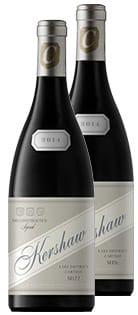Tim James: Deconstructing terroir – the roles of place, soil and clone
By Christian Eedes, 24 July 2017
Ambitious producers can’t talk long about their wines without sliding in some reference to terroir, or sense of place. But they can mean very different sort of places, and expressions of them. When Eben Sadie was establishing his Columella and Palladius early this century he was convinced that the Swartland needed blends (of both place and variety) in order to make a complete great wine. With those two wines, at least, he continues to pursue his wish to express the Swartland as a whole, rather than any smaller patch of soil and slope. It remains the dominant Swartland model, but a good handful of excellent wines (Porseleinberg syrah and David & Nadia’s single vineyard chenins for example) have shown that, at least in some sites, such blends are not necessary.
Remember when “estates” were defined in the Wine of Origin system as the smallest demarcation unit, and producers weren’t allowed to even mention the word “vineyard” on the label? In a sense, if we look to classic Europe, this is the Bordeaux/brand model (given that it doesn’t matter how large or diverse the estate may be), while the Burgundy model of terroir (ever smaller and more tightly defined parcels of land) is the one that, I dare say, drives more and more winemakers aspiring to greatness around the world today.
Stellenbosch, perhaps, still represents this estate model best. Take Waterford’s The Jem, where the aim is to include all the black grape varieties grown on the estate, in order to give an oenological picture of the totality. Or Remhoogte, who have renamed their Estate Blend as Chronicle Cape Blend and proudly, if grammatically carelessly, claim on the back label: “19 vineyard blocks on 8 different soils [sic] types over the estate’s 55 hectare’s [sic] all feature in this blend. This wine serves as a chronicle of our estate. A story of a vintage and our unique terroir captured….”
Now that’s a very different conception of terroir from those who aim to express minute particularity. It’s probably not a coincidence that makers of pinot noir, the great Burgundian grape, have been at the forefront locally of bottling similarly vinified wines from different origins, rather than blending them together. Hannes Storm, for example, has three small-volume bottlings of single-vineyard pinot, one from each of the wards of the Hemel-en-Aarde area.
Working backward, in a sense, and certainly not aiming to diminish their famous Family Reserve Pinot Noir, the Newton Johnsons now offer the flagship blend as well as small bottlings of the three vineyards whose grapes go into it. A dismantling, or deconstruction of the blend, as it were. Even more intricately, for their Seadragon version for the CWG auction, they’ve done a brilliant re-construction of a different sub-section of the blend, by selecting grapes only off a contour of clay through the vineyards.
Which brings us to a soil-type-based selection, rather than a simple origin-based one. A sense of soil, then, rather than a sense of place. The Marvellous Mullineux were (I think) the local pioneers in this, with syrahs and chenins coming off four different soils (but not necessarily from single vineyards). This strategy also seems to be on the rise; more recently I’ve noticed two new syrahs from Gabriëlskloof selected, or at least specified, on this basis (from shale and sandstone respectively), and two chenins from Spioenkop (shale and ferricrete), and there are probably others.
 But possibilities for going back to the building blocks don’t end there. Richard Kershaw, for his eponymous brand, now has, in addition to his blended Elgin versions, four chardonnays and two syrahs in his Deconstructed range. But the differences here are above all clonal ones (though soil and origin also play some role).
But possibilities for going back to the building blocks don’t end there. Richard Kershaw, for his eponymous brand, now has, in addition to his blended Elgin versions, four chardonnays and two syrahs in his Deconstructed range. But the differences here are above all clonal ones (though soil and origin also play some role).
It has to be said (or at least I have to admit for myself) that sometimes the differences between all these deconstructions based on place, soil or clone can be pretty subtle. Discernible, certainly, when you have them next to each other. Some are more distinctive than others but, on the whole, if you subjected me to the test of tasting them sighted in one room and then being confronted by a random line-up of the same wines in the next room, I’d feel very gratified if I correctly identified a small proportion with confidence.
Which is not in the least any disparagement by me of the aims and ardour behind their production. It’s all fascinating and enriching. Long live difference – whether origin, soil or clone.
- Tim James is founder of Grape.co.za and contributes to various local and international wine publications. He is a taster (and associate editor) for Platter’s. His book Wines of South Africa – Tradition and Revolution appeared in 2013.








Comments
0 comment(s)
Please read our Comments Policy here.